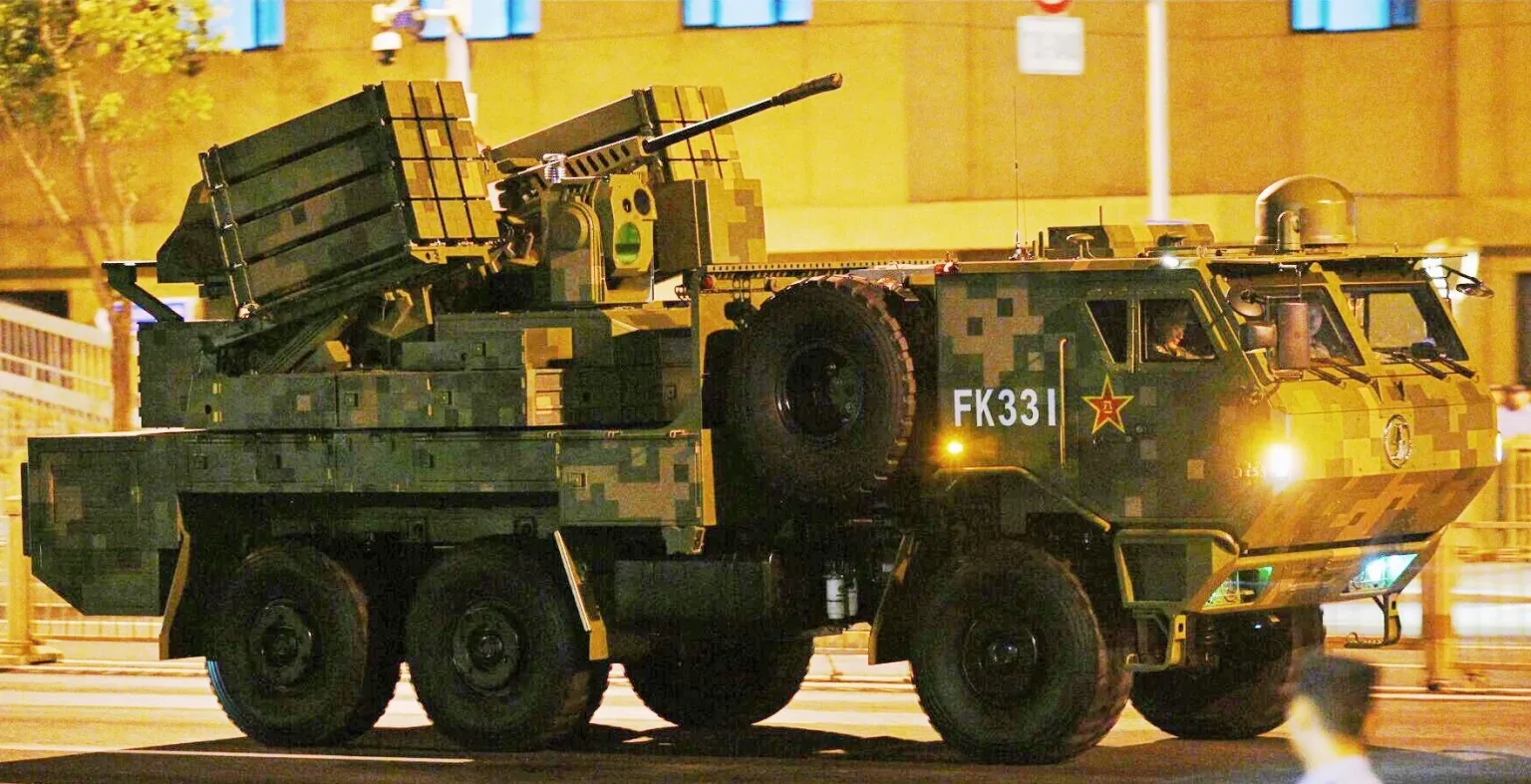Beijing has begun to field the FK-3000 anti-drone system. The platform targets mass, low-cost drones that fly at low altitude. Parade rehearsals in the capital point to an early deployment by the PLA[1].

Mission: Defeat low-altitude drones and swarms with layered effects[1].
Armament: 30mm automatic cannon + two pods with 12 short-range missiles each (24 total)[1].
Range window: ~300–12,000 m, per developer statements and show data[1], [4].
Design: Modular loadouts, including micro-missiles for high-capacity C-UAS[4].
Use cases: Site defense, convoy cover, urban security, and frontline SHORAD[1], [3].
Why a dedicated C-UAS layer matters now
Small, cheap drones are changing air defense. They come in numbers, at low altitude, and at a low cost per shot. As a result, classic systems built for jets or cruise missiles often struggle against saturation raids.
China’s answer is a focused SHORAD solution. The FK-3000 targets the same problem set that NATO and others now face: concurrency, magazine depth, and fast cueing for many small targets[6], [7], [8]. First shown at Zhuhai 2022, it is now visible in parade drills, which suggests the PLA is moving from display to fielding[2], [1].
How the FK-3000 counters swarms
The system blends two effectors. The 30mm cannon offers rapid, low-cost shots at short range. Meanwhile, the twin missile pods extend reach and allow multiple simultaneous engagements.
In the seen configuration, each pod holds 12 missiles. This supports staggered shot plans during a raid. Moreover, it keeps higher-tier interceptors free for harder threats[1].
Developers list an engagement window of roughly 300 to 12,000 meters. That band covers the most common drone profiles against convoys, bases, and maneuver units. In addition, the modular launcher can accept micro-missiles to increase ready-to-fire counts when needed[4].
Technical insight: Guns are cheap per round but need proximity fuzes and accurate tracking. Missiles add reach and a higher kill chance against evasive targets, yet magazines are limited. Therefore, a mixed gun-and-missile layout—like the FK-3000—helps balance cost, range, and concurrency[6], [7].
Fire control, sensors, and the network
Open sources give few sensor details. Even so, the platform is described as all-weather and networkable. In practice, that means faster cueing from distributed radars or electro-optical sensors and quicker hand-offs to shooters[6], [7].
Drone attacks rarely arrive as a single track. Instead, they come in waves, with decoys and jamming. Consequently, a single chassis that can fire guns and missiles reduces delay and simplifies shot decisions at the edge.
Modularity as an industrial strategy
The FK-3000 follows a broader shift in C-UAS design. Platforms now act as carriers for many effectors rather than fixed, single-mission systems. Hence, loadouts can change as threats evolve. New seekers, updated data links, or different fuze logic can be added with less redesign[4].
Lessons from recent wars
From Ukraine to the Middle East, low-cost drones hit both military targets and civilian sites. They force defenders to spend expensive interceptors on cheap threats. Therefore, many forces are buying low-cost interceptors, gun-based kits, and trialing directed-energy options to restore the cost curve[9], [10], [11].
The FK-3000 fits this trend. It adds a flexible, short-range layer to protect units and critical infrastructure. If fielded at scale and tied into resilient command networks, it can absorb large raids and preserve medium- and long-range magazines for higher-value targets.
Comparisons and watch items
Many modern SHORAD systems share core traits: high ready-to-fire counts, fast slewing, programmable airburst rounds, and compact missiles. Some also test high-power microwave or laser payloads for area effects at low cost[11]. Against this backdrop, the FK-3000 stands out for its magazine depth per vehicle and modular fit.
What to watch: confirmed sensor suite and data links; the mix of standard vs. micro-missiles; rules for shot allocation under saturation; links with EW and decoys; and, finally, production rate and unit cost. Together, these factors will shape density in the field and real-world performance.
Internal link: swarm tactics primer
For a deeper primer on swarm dynamics and countermeasures, see our explainer[12]. It outlines how timing, routing, and decoys stress defenders—and how layered C-UAS design, including the FK-3000 anti-drone system, can respond.
Conclusion
The FK-3000 anti-drone system shows a clear PLA move toward layered, high-capacity SHORAD. By pairing a 30mm cannon with two missile pods, it builds the concurrency and flexibility needed against mass raids. Next, the key test will be doctrine and scale: how units employ the system, how it networks, and how loadouts evolve as threats adapt.
Further Reading
DefenseNews: Counter-swarm test event[9]
The Defense Post: Directed-energy for C-UAS[11]
Defence Agenda: Swarm technology primer[12]
References
- Defence Blog — China fields new FK-3000 anti-drone system (Aug 24, 2025)
- SCMP — “Hard- and soft-kill” anti-drone system at Zhuhai 2022
- Global Times — FK-3000 at Airshow China 2022
- VPK — Range and mixed-missile layout claims
- US Army War College (SSI) — PLA counter-UAS portfolio (2025)
- NATO ACT — Countering Class 1 UAS (C-UAS) Handbook
- US Army ATP 3-01.81 — Counter-UAS (2023)
- CRS — DoD Counter-Unmanned Systems Strategy (2025)
- DefenseNews — Swarm-destruction demonstration (2024)
- National Defense — Kamikaze drones and SHORAD rethink (2024)
- The War Zone — HPM for counter-swarm (2025)
- Defence Agenda — Unleashing the Power of Swarm Technology








